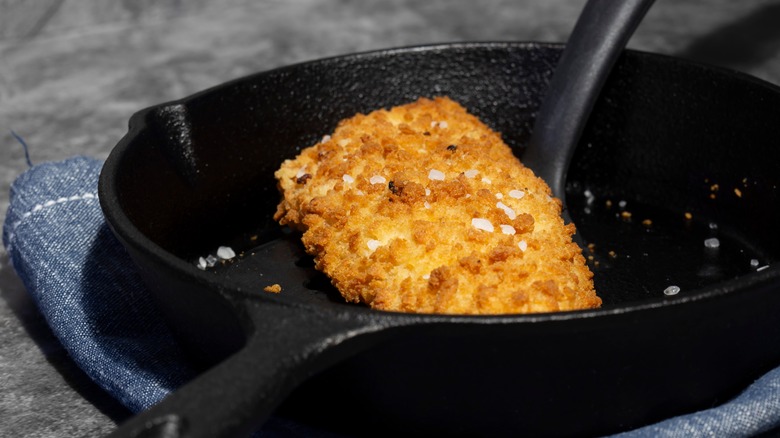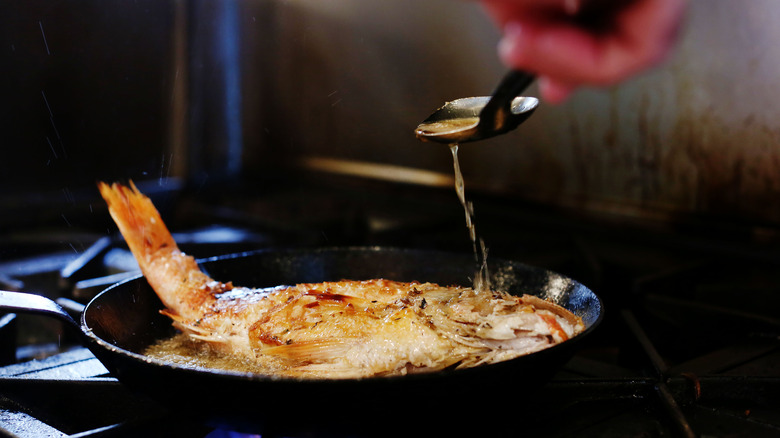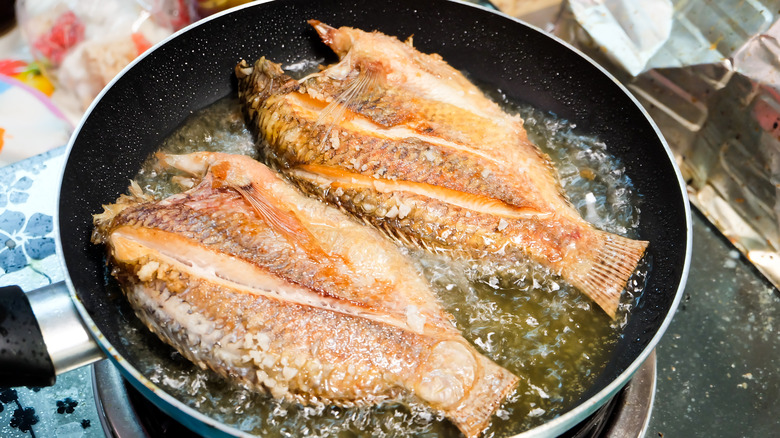For The Crispiest Fried Fish, Choosing The Right Pan Is Crucial
Fish is a delightful protein option, offering flavorful and tender flesh that's easy to complement with a range of ingredients. Not to mention it's nutritionally dense, high in omega-3 fatty acids, and low in saturated fat — and so eating fish twice a week is absolutely okay. Easy to see why it's the perfect weekday dinner candidate, leaving only one minor complication: cooking the fish.
Especially when frying a skin-on filet, preparing the food might feel intimidating — burnt skin and mushy flesh can put anyone off. So turn your attention to which pan you're using — it'll make a crucial difference. Throw the exact same fish onto a nonstick as opposed to a cast iron or stainless steel, and you'll get totally different results. You'll want to stick to the latter, more heat-ready pans, to get that oil temperature hot enough for when the fish hits the pan.
In fact, placing the filet onto a cool vessel is one of the big mistakes to avoid when cooking fish. So get your best pan ready, and you'll be well on your way to integrating crispy fried fish into your dinner rotation.
Employ high heat on cast iron or stainless steel for the tastiest fried fish
When you picture the delicate nature of fish, it may seem contradictory to reach for a hefty pan. The smooth, and fuss-free nature of nonstick tempts for the application. However, contradictory to expectation, this pan type actually leads to more burning. At hot temperatures meant for searing, the non-stick surface functions unevenly, leaving some of your filet overcooked in spots.
Additionally, non-stick pans don't bode well at high temperature cooking. The chemical coating starts to deteriorate, creating fumes and potential off-putting tastes. It's advised to avoid preheating the pan with food, as well as using it above medium heat; two tactics that conflict with crispy fish skin.
As a result, stick to more heat-ready stainless steel and cast iron for the task. With the right amount of oil, you won't have to worry about any skin sticking, and definitely no risk of toxic aromas. So season a cast iron pan beforehand, and prepare your fish stress-free.
Prep the fish for optimal crispiness
Crispiness arises due to the swift removal of moisture, so the magic isn't exclusively in the pan. Removing extra liquid from the fish — especially if there's skin — will be helpful in achieving textural yumminess. Using a long chef's knife, gently drag the blade across the skin, spritzing out some moisture in the process. After a few rounds, your knife should be dry, so then follow with a very gentle paper towel drying. Only once there's little excess moisture is the fish ready for salt and pepper seasoning.
Next, you'll want to carefully select the proper fat for the task. The best type of oil to use for shallow frying should have a moderate smoke point, making vegetable-based varieties like canola an excellent candidate. Make sure to verify that both the pan and oil are hot enough by placing a small cut of fish first; it should be able to move around without friction. If temperatures are high but there's still some sticking, then you'll want to re-season the pan.
Once cooking starts, the filet typically curls up; simply press down with a spatula to flatten it. From then on, avoid tampering with the fish. You'll want to lower the heat to a medium to avoid burning — and perhaps add a butter baste for extra moisture. Gently flip, and let the fish sauté to tasty completion.


